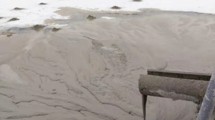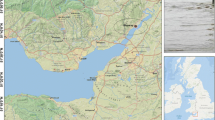Abstract
Alluvial fan is one of the environments having good potential for aggregate exploitation. Morphometric properties of alluvial fans’ catchment such as area and length of main channel have important role in the aggregate attributes. The aim of this research is to study the relation between morphometric characteristics of catchments and aggregate size and weight loss resulted from freeze–thaw and sodium sulfate soundness. To achieve the aim of this study, 12 alluvial fans on northwest of Direh catchment in Gilan-e Gharb county were selected. All selected fans having catchments with similar lithology were selected in this study in order to eliminate the effect of lithological differences in freezing–thawing test. Results show that as area and length of main channel in catchments increase, the rates of fracture, weight loss due to freezing–thawing, and sodium sulfate soundness decrease. The rate of weight loss is originated from morphometric characteristics of alluvial fans’ catchments. As area and length of main channel in catchments increase, the weight loss difference (from freezing–thawing and sodium sulfate soundness) between fine and coarse aggregates decreases. Indeed, the effect of particle size in the intensity of weight loss reduces with increase in area and length of main channel of catchments.













Similar content being viewed by others
References
ASTM C 88-99a (1999) Standard test method for soundness of aggregates by use of sodium sulfate or magnesium sulfate. Annual Book of ASTM Standards, vol 04.02, ASTM, Philadelphia
ACI 201 (2008) Guide to durable concrete. ACI Committee 201 report, ACI 201.2R-08. American Concrete Institute, Farmington Hills
Alexander M, Mindess S (2005) Aggregate in concrete. Taylor & Francis, London
Almeida LCR, Marques EAG, Vargas Jr. EA, Barros WT (1998) Characterization and utilization of tensile strength and toughness of granitic and gneissic rocks of Rio De Janeiro City—a proposal for optimizing rock blasting processes. In: Moore DP, Hungr O (eds) Proceedings of eighth international congress of IAEG, vol 1. Balkema, Vancouver, pp 351–357
Bahrami S (2013) Tectonic controls on the morphometry of alluvial fans around Danehkhoshk anticline, Zagros, Iran. Geomorphology 180–181:217–230
Bahrami S, Fatemi Aghda SM, Bahrami K, Motamedi Rad M, Poorhashemi S (2015) Effects of weathering and lithology on the quality of aggregates in the alluvial fans of Northeast Rivand, Sabzevar, Iran. Geomorphology 241:19–30
Beaumont P (1972) Alluvial fans along the foothills of the Elburz Mountains, Iran. Palaeogeogr Palaeoclimatol Palaeoecol 12:251–273
Bektas F, Cai W, Wang K (2016) Aggregate freezing-thawing performance using the Iowa pore index. Center for Transportation Research and Education, Iowa State University, Ames
Blair TC (1999) Cause of dominance by sheet flood versus debris flow processes on two adjoining alluvial fans, Death Valley, California. Sedimentology 46:1015–1028
Blair TC, MacPherson JG (1994) Alluvial fan processes and forms. In: Abrahams AD, Parsons AJ (eds) Geomorphology of desert environments. Chapman and Hall, London
Blair TC, McPherson JG (1998) Recent debris-flow processes and resultant form and facies of the Dolomite alluvial fan, Owens Valley, California. J Sediment Res 68:800–818
Bryan DP, Castor SB, Johnson GL (2000) Aggregate resource study, western portion of the Carson City BLM District, Nevada, with addendum, economic potential. NBMG Open-file report 2000-3
Bull WB (1977) The Alluvial-Fan environment. Prog Phys Geogr 1:222–270
Calvache ML, Viseras C, Fernandez J (1997) Controls on fan development—evidence from fan morphometry and sedimentology; Sierra Nevada, SE Spain. Geomorphology 21:69–84
Crosta GB, Frattini P (2004) Controls on modern alluvial fan processes in the central Alps, northern Italy. Earth Surf Proc Land 29:267–293
Dade WB (2007) Tectonic and climatic controls of alluvial-fan size and source catchment relief. J Geol Soc Lond 164:353–358
De Scally FA, Owens IF (2004) Morphometric controls and geomorphic responses on fans in the Southern Alps, New Zealand. Earth Surf Proc Land 29(3):311–322
De Scally F, Slaymaker O, Owens I (2001) Morphometric controls and basin response in the Cascade Mountains. Geogr Ann 83A(3):117–130
Denny CS (1965) Alluvial fans in the Death Valley region, California and Nevada. US Geological Survey Professional Paper 466
Dorn RI (1994) The role of climatic change in alluvial fan development. In: Abrahams AD, Parsons AJ (eds) Geomorphology of desert environments. Chapman and Hall, London, pp 354–402
Field J (2001) Channel avulsion on alluvial fans in southern Arizona. Geomorphology 37:93–104
French RH, Miller JJ (2012) Flood hazard identification and mitigation in semi- and arid environments. World Scientific, Singapore
Gohain K, Parkash B (1990) Morphology of the Kosi megafan. In: Rachocga AH, Church M (eds) Alluvial fans: a field approach. Wiley, Chichester, pp 151–178
Goswami PK, Pant CC, Pandey S (2009) Tectonic controls on the geomorphic evolution of alluvial fans in the Piedmont Zone of Ganga Plain, Uttarakhand, India. J Earth Syst Sci 118:245–259
Gupta S (1997) Himalayan drainage patterns and the origin of fluvial megafans in the Ganges foreland basin. Geology 25:11–14
Hartley AJ, Weissmann GS, Nichols GJ, Warwick GL (2010) Large distributive fluvial systems: characteristics, distribution, and controls on development. J Sediment Res 80(2):167–183
Harvey AM (1997) The role of alluvial fans in arid-zone fluvial systems. In: Thomas DSG (ed) Arid Zone Geomorphology; Process, Form And Change In Drylands, 2nd edn. Wiley, Chichester, pp 231–259
Harvey AM (2002) The role of base-level change in the dissection of alluvial fans: case studies from southeast Spain and Nevada. Geomorphology 45:67–87
Harvey AM (2012) The coupling status of alluvial fans and debris cones: a review and synthesis. Earth Surf Proc Land 37:64–76
Harvey AM, Wells SG (2003) Late quaternary alluvial fan development, relations to climatic change, Soda Mountains, Mojave Desert, California. In: Lancaster N, Enzel Y, Wells SG (eds) Environmental change in the Mojave Desert. Special paper 368. Geological Society of America, Boulder, pp 207–230
Ibbeken H, Warnke DA, Diepenbroek M (1998) Granulometric study of the Hanaupah fan, Death Valley, California. Earth Surf Proc Land 23:481–492
Janssen DJ, Snyder MB (1994) Resistance of concrete to freezing and thawing. Report SHRP-C-391. Strategic Highway Research Program, Washington, DC
Kostaschuk R, MacDonald GM, Putnam PE (1986) Depositional process and alluvial fan - drainage basin morphometric relationships near Banff, Alberta, Canada. Earth Surf Proc Land 11(5):471–484
Lin Z, Oguchi T (2004) Drainage density, slope angle, and relative basin position in Japanese bare lands from high-resolution DEMs. Geomorphology 63:159–173
Litvan GG (1973) Pore structure and frost susceptibility of building materials. Research Paper No. 584, Division of Building Research, National Research Council of Canada, Ottawa, pp 17–30
MacInnis C, Lau EC (1971) Maximum aggregate size effect on frost resistance of concrete. ACI J 68:144
Matsuoka N (1990) Mechanisms of rock breakdown by frost action: an experimental approach. Cold Reg Sci Technol 17:253–270
McDonald EV, McFadden LD, Wells SG (2003) Regional response of alluvial fans to the Pleistocene–Holocene climatic transition, Mojave Desert, California. In: Enzel Y, Wells SG, Lancaster N (eds) Paleoenvironments and paleohydrology of the Mojave and Southern Great Basin Deserts. Special paper 368. Geological Society of America, Boulder, pp 189–205
Mindess S, Young JF, Darwin D (2003) Concrete. Pearson Prentice Hall, Upper Saddle River, pp 121–163
Montoto AM, Rodríguez-Rey A, Menéndez B, Martínez-Nistal A, Ruiz de Argandoña VG, Suárez del Río LM, Calleja L (1994) Microfractography of “El Berrocal granite”. In: Maravic H, Smellie J (eds) Proceedings of an international workshop “Nuclear science and technology”, pp 353–358
Nicholson DT, Nicholson FH (2000) Physical deterioration of sedimentary rocks subjected to experimental freezing and thawing. Earth Surf Proc Land 25:1295–1307
Oguchi T (1997) Drainage density and relative relief in humid steep mountains with frequent slope failure. Earth Surf Proc Land 22:107–120
Park J, Hyun CU, Park HD (2015) Changes in microstructure and physical properties of rocks caused by artificial freeze–thaw action. Bull Eng Geol Env 74:555–565
Piasta W, Góra J, Turkiewicz T (2016) Properties and durability of coarse igneous rock aggregates and concretes. Constr Build Mater 126:119–129
Pope RJJ, Wilkinson KN (2005) Reconciling the roles of climate and tectonics in Late Quaternary fan development on the Spartan piedmont, Greece. In: Harvey AM, Mather AE, Stokes M (eds) Alluvial fans: geomorphology, sedimentology, dynamics. Special publications 251. Geological Society, London, pp 133–152
Richardson DN (2009) Quick test for durability factor estimation. Final Report 0R09.020. Missouri Department of Transportation, pp 24–30
Ruedrich J, Kirchner D, Siegesmund S (2011) Physical weathering of building stones induced by freeze–thaw action: a laboratory long-term study. Environ Earth Sci 63:1573–1586
Sánchez-Núñez JM, Macías JL, Saucedo R, Zamoranod JJ, Novelo D, Mendoza ME, Torres-Hernández JR (2015) Geomorphology, internal structure and evolution of alluvial fans at Motozintla, Chiapas, Mexico. Geomorphology 230:1–12
Scaly FA, Owens IF (2005) Depositional processes and particle characteristics on fans in the Southern Alps, New Zealand. Geomorphology 69:46–56
Schedl A, Kronenberg AK, Tullis J (1986) Deformation microstructures of Barre granite: an optical SEM and TEM study. Tectonophysics 122:149–164
Smith MR, Collis L (2001) Aggregates: sand, gravel and crushed rock aggregates for construction purposes, 3rd edn. The Geological Society, London
Snyder NP, Whipple KX, Tucker GE, Merritts DJ (2003) Channel response to tectonic forcing: field analysis of stream morphology and hydrology in the Mendocino triple junction region, northern California. Geomorphology 53(1–2):97–127
Sorriso-Valvo M, Antronico L, Le Pera E (1998) Controls on modern fan morphology in Calabria, Southern Italy. Geomorphology 24:169–187
Tailing P, Sowter MJ (1999) Drainage density on progressively tilted surfaces with different gradients, Wheeler Ridge, California. Earth Surf Proc Land 24:809–824
Talling PJ (2000) Self-organization of river networks to threshold states. Water Resour Res 36(4):1119–1128
TEX-432-A (2014) Test procedure for coarse aggregate freeze–thaw test. Texas Department of Transportation
Thomachot C, Jeanette D (2002) Evolution of the petrophysical properties of two types of Alsatian sandstone subjected to simulated freeze–thaw conditions. In: Siegesmund S, Weiss T, Vollbrecht A (eds) Natural stone, weathering phenomena, conservation strategies and case studies. Special publication no. 205. Geological Society, London, pp 19–32
Tucker GE, Hancock GR (2010) Modelling landscape evolution. Earth Surf Proc Land 35:28–50
Viseras C, Calvache ML, Soria JM, Fernández J (2003) Differential features of alluvial fans controlled by tectonic or eustatic accommodation space. Examples from the Betic Cordillera, Spain. Geomorphology 50:181–202
Wang P, Xu J, Liu S, Liu S, Wang H (2016) A prediction model for the dynamic mechanical degradation of sedimentary rock after a long-term freeze–thaw weathering: Considering the strain-rate effect. Cold Reg Sci Technol 131:16–23
Washburn AL (1979) Geocryology: a survey of periglacial processes and environments. Edward Arnold, London
Waters JV, Jones SJ, Armstrong HA (2010) Climatic controls on late Pleistocene alluvial fans, Cyprus. Geomorphology 115:228–251
Weissman GS, Bennett GL, Lansdale AL (2005) Factors controlling sequence development on Quaternary fluvial fans, San Joaquin Basin, California, U.S.A. In: Harvey AM, Mather AE, Stokes M (eds) Alluvial Fans: geomorphology, sedimentology, dynamics. Special publication 251. Geological Society, London, pp 169–186
Weissmann G, Hartley A, Nichols G, Scuderi L, Olson M, Buehler H, Banteah R (2010) Fluvial form in modern continental sedimentary basins: distributive fluvial systems. Geology 38(1):39–42
Whipple KX, Trayler CR (1996) Tectonic control of fan size: the importance of spatially variable subsidence rates. Basin Res 8:351–366
Yavuz H, Altindag R, Sarac S, Ugur I, Sengun N (2006) Estimating the index properties of deteriorated carbonate rocks due to freeze–thaw and thermal shock weathering. Int J Rock Mech Min Sci 43:767–775
Author information
Authors and Affiliations
Corresponding author
Rights and permissions
About this article
Cite this article
Bahrami, K., Fatemi Aghda, S.M., Noorzad, A. et al. Effect of Morphometric Characteristics of Catchments on the Aggregates’ Resistance of Freeze–Thaw and Sodium Sulfate Soundness: A Case Study of Alluvial Fans of Direh, Kermanshah, Iran. Iran J Sci Technol Trans Sci 43, 1575–1589 (2019). https://doi.org/10.1007/s40995-019-00686-5
Received:
Accepted:
Published:
Issue Date:
DOI: https://doi.org/10.1007/s40995-019-00686-5




